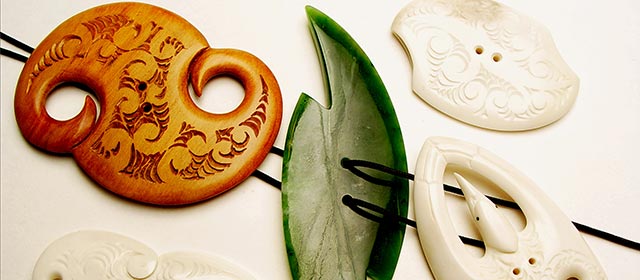Story summary
Musical traditions
Taonga puoro (traditional Māori musical instruments) are seen as children of the families of the gods who brought them into being. ‘Rangi’ is the word for tunes, and the name of the primal Sky Father to whom music drifts up – so melodic instruments are from the world of Rangi. The heartbeats of Papatūānuku, the Earth Mother, are the basis of musical rhythms.
Instruments are used for both spiritual and physical purposes – for instance, a kōauau (flute) can be used to summon spirits for healing, or to make people laugh. Traditionally music was played for reasons such as sending messages or marking the stages of life.
Taonga puoro are given personal names, and are made so that each is individual and has its own voice. They are grouped in whānau (extended families), and are seen as gifts from the gods. Some belong to more than one family.
Melodic instruments – the family of Rangi
In tradition, Raukatauri, the goddess of flute music, changed herself into a case moth and is said to live inside her flute. Instruments in the flute family include kōauau, flutes made from wood or bone, and pūtōrino, flutes shaped like the case moth’s cocoon, which can be played through three different holes.
Hinepūtehue, the daughter of forest god Tāne Mahuta, sang to calm a quarrel. She became the goddess of hue (gourd) instruments, including large gourds with their tops cut off, which are blown over to make booming sounds; tiny ones played with the nose; and rhythmic shakers containing seeds or pebbles.
Trumpets made from shells and wood include the pūtātara, a signalling trumpet, and the pūkāea, a wooden trumpet up to 2.5 metres long, which sounded alerts in wartime and is used for announcements or events.
Rhythmic instruments – the family of Papa
Rhythmic instruments include:
- tumutumu, pieces of stone, wood or bone that are tapped with strikers
- poi, balls of dried flax on string that are swung and tapped, often by groups of women during dances
- porotiti and pūrerehua, discs on a cord which are spun, and are sometimes used for healing or making rain.
Decline and revival
After Europeans settled in New Zealand and Christianity spread, many ceremonies at which taonga puoro were played disappeared. Māori began playing European instruments instead. Taonga puoro became rare, and younger Māori did not learn to play them.
A hui about taonga puoro was held in 1991. After this, Hirini Melbourne, Richard Nunns, Brian Flintoff and others began working to revive these instruments. In the 2000s the sounds of taonga puoro were familiar, and many musicians had used them in their work.





